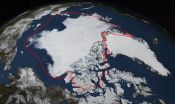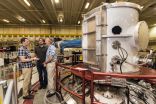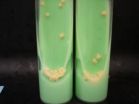(Press-News.org) Arctic sea ice coverage continued its below-average trend this year as the ice declined to its annual minimum on Sept. 17, according to the NASA-supported National Snow and Ice Data Center (NSIDC) at the University of Colorado, Boulder.
Over the 2014 summer, Arctic sea ice melted back from its maximum extent reached in March to a coverage area of 1.94 million square miles (5.02 million square kilometers), according to analysis from NASA and NSIDC scientists. This year's minimum extent is similar to last year's and below the 1981-2010 average of 2.40 million square miles (6.22 million square km).
"Arctic sea ice coverage in 2014 is the sixth lowest recorded since 1978. The summer started off relatively cool, and lacked the big storms or persistent winds that can break up ice and increase melting," said Walter Meier, a research scientist at NASA's Goddard Space Flight Center in Greenbelt, Maryland.
"Even with a relatively cool year, the ice is so much thinner than it used to be," Meier said. "It's more susceptible to melting."
This summer, the Northwest Passage above Canada and Alaska remained ice-bound. A finger of open water stretched north of Siberia in the Laptev Sea, reaching beyond 85 degrees north, which is the farthest north open ocean has reached since the late 1970s, according to Meier.
While summer sea ice has covered more of the Arctic in the last two years than in 2012's record low summer, this is not an indication that the Arctic is returning to average conditions, Meier said. This year's minimum extent remains in line with a downward trend; the Arctic Ocean is losing about 13 percent of its sea ice per decade.
To measure sea ice extent, scientists include areas that are at least 15 percent ice-covered. The NASA-developed computer analysis, which is one of several methods scientists use to calculate extent, is based on data from NASA's Nimbus 7 satellite, which operated from 1978 to 1987, and the U.S. Department of Defense's Defense Meteorological Satellite Program, which has provided information since 1987.
In addition to monitoring sea ice from space, NASA is conducting airborne field campaigns to track changes in Arctic sea ice and its impact on climate. Operation IceBridge flights have been measuring Arctic sea ice and ice sheets for the past several years during the spring. A new field experiment, the Arctic Radiation – IceBridge Sea and Ice Experiment (ARISE) started this month to explore the relationship between retreating sea ice and the Arctic climate.
INFORMATION:
For more information on sea ice observations from space, visit:
http://nsidc.org/data/seaice/
NASA monitors Earth's vital signs from land, air and space with a fleet of satellites and ambitious airborne and ground-based observation campaigns. NASA develops new ways to observe and study Earth's interconnected natural systems with long-term data records and computer analysis tools to better see how our planet is changing. The agency shares this unique knowledge with the global community and works with institutions in the United States and around the world that contribute to understanding and protecting our home planet.
For more information about NASA's Earth science activities in 2014, including the Operation IceBridge and ARISE airborne campaigns, visit:
http://www.nasa.gov/earthrightnow
2014 Arctic sea ice minimum sixth lowest on record
2014-09-23
ELSE PRESS RELEASES FROM THIS DATE:
Actions on climate change bring better health, study says
2014-09-23
MADISON, Wis. — The number of extremely hot days in Eastern and Midwestern U.S. cities is projected to triple by mid-century, according to a new study led by University of Wisconsin-Madison researchers and published today in the Journal of the American Medical Association.
Milwaukee and New York City could experience three times as many 90-degree days by 2046; Dallas could see twice as many days topping 100 degrees. The new analysis offers climate data through the lens of public health, in a study that represents a synthesis of the latest science at the intersection of ...
Sandia magnetized fusion technique produces significant results
2014-09-23
ALBUQUERQUE, N.M. — Researchers at Sandia National Laboratories' Z machine have produced a significant output of fusion neutrons, using a method fully functioning for only little more than a year.
The experimental work is described in a paper to be published in the Sept. 24 Physical Review Letters online. A theoretical PRL paper to be published on the same date helps explain why the experimental method worked. The combined work demonstrates the viability of the novel approach.
"We are committed to shaking this [fusion] tree until either we get some good apples or a ...
Critically ill ICU patients lose almost all of their gut microbes and the ones left aren't good
2014-09-23
Researchers at the University of Chicago have shown that after a long stay in the Intensive Care Unit (ICU) only a handful of pathogenic microbe species remain behind in patients' intestines. The team tested these remaining pathogens and discovered that some can become deadly when provoked by conditions that mimic the body's stress response to illness.
The findings, published in mBio®, the online open-access journal of the American Society for Microbiology, may lead to better monitoring and treatment of ICU patients who can develop a life-threatening systemic infection ...
Video blinds us to the evidence, NYU, Yale study finds
2014-09-23
Where people look when watching video evidence varies wildly and has profound consequences for bias in legal punishment decisions, a team of researchers at New York University and Yale Law School has found. This study raises questions about why people fail to be objective when confronted with video evidence.
In a series of three experiments, participants who viewed videotaped altercations formed biased punishment decisions about a defendant the more they looked at him. Participants punished a defendant more severely if they did not identify with his social group and punished ...
AWHONN recommends reducing overuse of labor induction
2014-09-23
Washington, DC, September 23, 2014 —The Association of Women's Health, Obstetric and Neonatal Nurses (AWHONN) is calling upon healthcare providers and pregnant women to avoid induction of labor at any time during pregnancy unless it is medically necessary.
Approximately one-in-four U.S. births are induced, a number that has more than doubled since 1990. While there are limited data to distinguish how many of these inductions are for medical and non-medical reasons, there is no data to suggest that the significant increase in the induction rate is attributable to a similar ...
New measure provides more data on oxygen levels during sedation
2014-09-23
September 23, 2014 – The "area under the curve of oxygen desaturation" (AUCDesat) may provide a more sophisticated approach to monitoring blood oxygen levels during procedures using sedation, according to a study published in Anesthesia & Analgesia.
The AUCDesat provides information not only whether blood oxygenation has dropped too low—but also on the depth, duration, and rate of episodes of oxygen desaturation. The new study by Paul Niklewski, PhD, of University of Cincinnati and colleagues reports on the development of the AUCDesat as a potentially useful new approach ...
Termites evolved complex bioreactors 30 million years ago
2014-09-23
Achieving complete breakdown of plant biomass for energy conversion in industrialized bioreactors remains a complex challenge, but new research shows that termite fungus farmers solved this problem more than 30 million years ago. The new insight reveals that the great success of termite farmers as plant decomposers is due to division of labor between a fungus breaking down complex plant components and gut bacteria contributing enzymes for final digestion.
Sophisticated Management in Termite Fungus Farms
Fungus-farming termites are dominant plant decomposers in (sub)tropical ...
Speaking of Chemistry: Why we need antibiotics (video)
2014-09-23
WASHINGTON, Sept. 23, 2014 — Antibiotics revolutionized health care in the early 20th century, helping kill bacteria that once killed thousands of people. But bacteria are also constantly outsmarting science, and new strains of antibiotic-resistant bacteria are popping up more frequently. This week's Speaking of Chemistry focuses on the current shortage of new antibiotics and discusses the prospects for new drugs. The episode also answers the question: Why should you finish your pills if you feel better? Check it out at: http://youtu.be/MAoDuSxXIUQ.
Antibiotics are just ...
Brain wave may be used to detect what people have seen, recognize
2014-09-23
Brain activity can be used to tell whether someone recognizes details they encountered in normal, daily life, which may have implications for criminal investigations and use in courtrooms, new research shows.
The findings, published in Psychological Science, a journal of the Association for Psychological Science, suggest that a particular brain wave, known as P300, could serve as a marker that identifies places, objects, or other details that a person has seen and recognizes from everyday life.
Research using EEG recordings of brain activity has shown that the P300 ...
Researchers develop new DNA sequencing method to diagnose tuberculosis
2014-09-23
Researchers working in the UK and The Gambia, have developed a new approach to the diagnosis of tuberculosis (TB) that relies on direct sequencing of DNA extracted from sputum (a technique called metagenomics) to detect and characterize the bacteria that cause TB without the need for time-consuming culture of bacteria in the laboratory.
The research, reported today in the peer-reviewed journal PeerJ, was directed by Professor Mark Pallen, Professor of Microbial Genomics at Warwick Medical School and Dr Martin Antonio, head of the TB diagnostics laboratory at UK Medical ...



